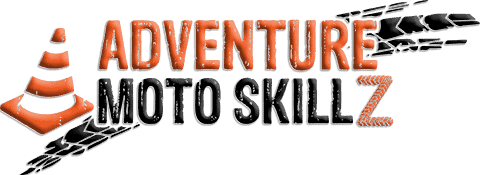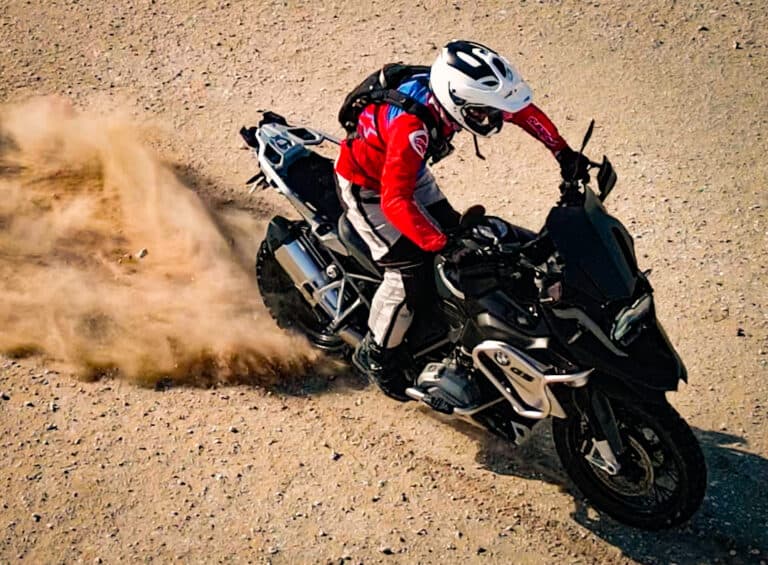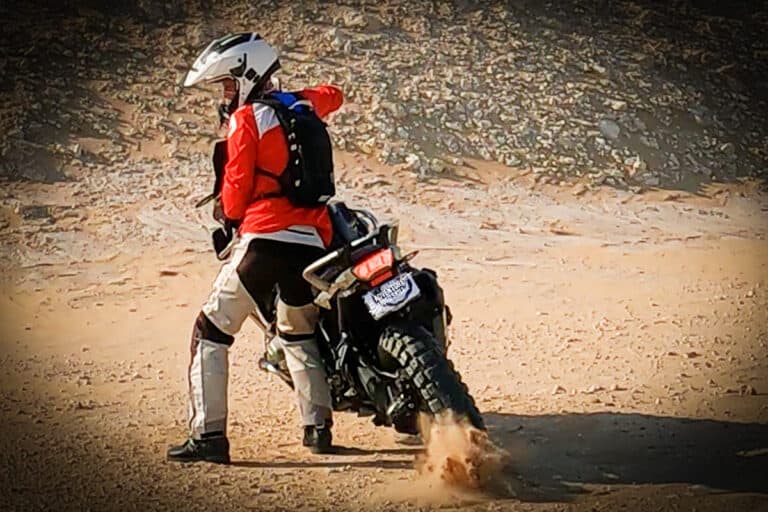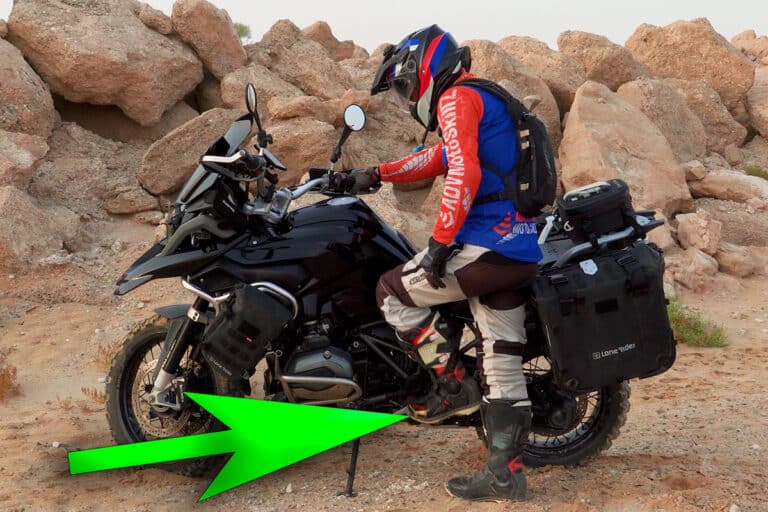Motorcycle Center Stand & Kickstand – When & How to Use Them
Center stands on motorcycles seem to vex many riders, but it does not need to be that way. For example, if you have an adventure motorcycle, it may have come stock with a center stand and a kickstand. Both supports can have their place in your riding routine with a bit of practice and know-how.
A motorcycle center stand supports a bike during maintenance and storage. A rider of any size or strength can engage the center stand using proper technique. The kickstand is the bike’s primary support at rest and is operated by raising or lowering with a foot push.

Kickstands are standard on all street legal bikes, whereas center stands are not. So if your bike has both stands and you struggle with the center stand, this post is for you. Here we show simple techniques to get on and off the center stand while also examining when to use each stand.
This post may contain Affiliate Links. Please see our Privacy & Disclosure Policy for more details.

Innovative Motorcycle Tool Sets – Compact & Reliable
Used and recommended by ADVMotoSkillZ
Center stand versus kickstand
The center stand attaches to the underbelly of the bike. When not used, it tucks up behind the engine close to the rear tire. It has a small lever arm on the left side, providing a leverage point to step on and lift the bike.
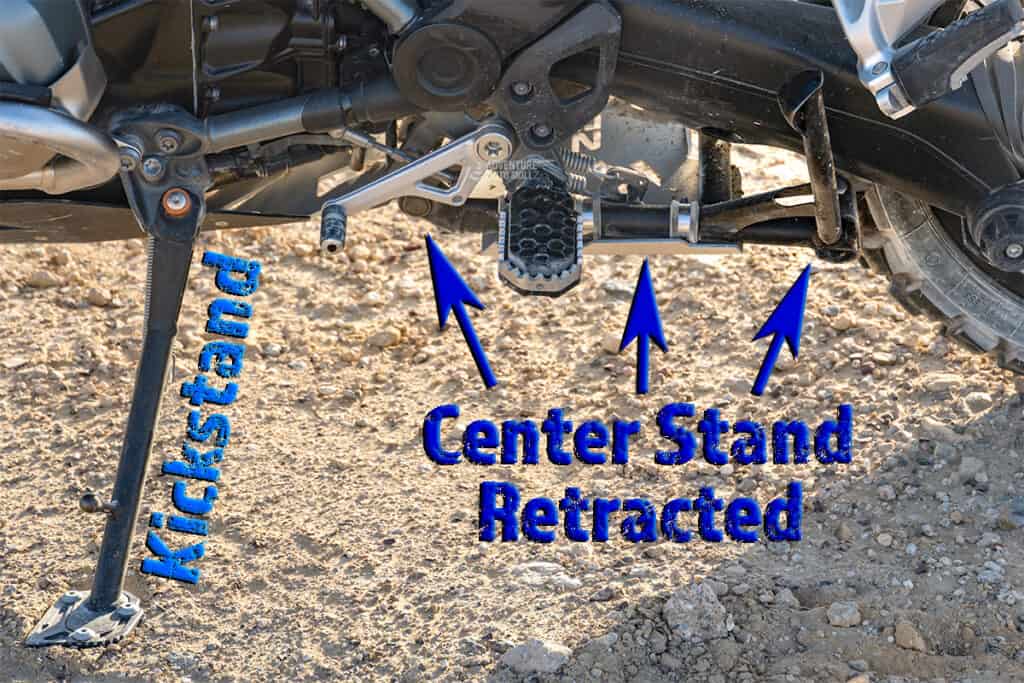
When extended down, the center stand holds the rear of the bike in the air. The bike can then be tilted so that either tire can be weightless. This vertical position stabilizes the motorcycle for any maintenance needs or for washing the bike. If you’re not riding your bike during the off-season, it’s best to store it on a center stand. This position will prevent flat spots from forming on the tires.
Kickstands, also known as sidestands, are the everyday use support structure of the bike. The kickstand supports the bike from the left side and creates a leftward lean when in use. When the bike is at rest, a kickstand allows the rider to walk away from it, leaving it safely upright.
A rider’s decision on whether to use the center stand or kickstand is case by case. The two prongs of the center stand must have a solid surface to sit on. Soft sand or sinking mud will not do the job for the center stand. Asphalt, cement, or hard-pack off-road are better suited to support a heavy bike on its center stand.

A center stand is helpful for parking the bike in tight/congested spots because it holds the bike vertically upright. A kickstand allows the bike to lean and therefore requires a larger spot to park the bike.
The kickstand is the go-to support device for most riders. They are easy to use and allow for easy parking or rest. Using an aftermarket side stand enlarger can improve the bike’s stability when parking it on off-road surfaces. These also help prevent the side stand from sinking into melting asphalt on summer days.
Some riders use sidestand coasters or plastic discs that they put on the ground under the tip of the kickstand. These are also useful if you park the bike somewhere you do not want to scratch (like behind the couch in the living room!)
How to get the motorcycle onto the center stand
Successful use of the center stand is all about leverage and technique. For example, an adult rider of any size can learn this skill for repeated center stand usage.
Have a look at this video showing a BMW R1200GS going onto its center stand:
Center stand lifting tips:
- Stand on the left side of the bike
- Ensure the bike is off and in 1st gear
- Use left hand to hold the handlebar and pull in the clutch*
- Right hand on the pillion grab bar
- Tip the bike vertical and lift the kickstand up
- Place right foot onto the center stand lever and push the center stand prongs down to the ground
- Ensure both prongs are firmly planted on the ground
- Step up onto the center stand lever to place all your weight vertically over the lever
- During the step up, keep the front wheel straight with the left hand
- Use your right hand to lift the bike upwards and slightly rearward (towards the 2 o’clock position)
- The tension of the center stand spring will be felt under your foot
- Keep your body weight balanced on the lever until the center stand clicks into place
- With the bike secure and upright, step back off and release handholds
* NOTE: If the lift attempt fails and the wheels come back down to the ground, feather the clutch out to stop any forward roll. If the bike is in gear during a failed lift attempt, the bike will not roll upon landing but can bounce with force and sometimes tip.
Things to avoid when lifting the bike onto the center stand:
- Do not try to lift the bike with your arms
- Do not attempt to elevate the motorcycle with leg strength only; you must step up to use full body weight
- Do not hunch your back or fold at the hips as you step up; instead, stand up tall to maximize your leverage
- Do not allow the bike to lean left or right; the bike must be perpendicular to the ground at its balance point

Top-quality gear for your next adventure
Used and recommended by ADVMotoSkillZ
How to get the bike off the center stand
Before taking the bike off the center stand, inspect the area in front of the bike. Ensure the area is safe for the bike to roll towards as it comes down. Likewise, check the site to the left of the bike to confirm a good location for the kickstand. Once this 5-second check is complete, it’s time to take the bike down.
This video shows a standard technique to take the bike down from its center stand:
Tips to bring the bike off of the center stand (Standard Technique):
- For safety, the bike is off and in 1st gear
- Kickstand should be up
- Use left hand to hold the handlebar and pull in the clutch*
- Right hand on the pillion grab bar
- Turn your body to face in the same direction that the bike will travel
- Firmly plant your right foot next to the rear tire
- Lift your left leg and take a big step forward with your full body weight
- Left hand keeps the front wheel straight while the right hand drags the bike forward
- Be prepared to feel the front suspension compress and rebound as the bike hits the ground
- Once the bike is down, you can feather the clutch out to stop any forward roll
- Either put the kickstand down or mount it for a ride
* NOTE: If the bike is in gear during this technique, the bike will not roll upon landing but can bounce with force and sometimes tip.
Things to avoid when bringing the bike off of the center stand:
- Do not try to push the bike forward with your arms
- Do not allow the bike to lean left or right
- Do not push the bike away from you as it comes down
SAFETY TIP: If the bike tips to the point of no return, then do not try to save it! Let it fall and avoid personal injury.
BONUS technique to get your bike off the center stand (for advanced riders):
The rider can get the bike off the center stand while mounted on the bike. This technique is best used when you will be riding off immediately. Do not attempt this maneuver if you are not confident in your bike balance skills.
Tips to bring the bike off the center stand while mounted (Advanced Technique):
- Mount the motorcycle and assume the standing rider position
- Turn on the engine, put the bike in 1st gear & pull in the clutch
- Transfer hips rearward to prepare for a forward thrust
- Then transfer hips forward while pressing down through the foot pegs
- Be sure to squeeze the narrow part of the seat with knees
- The shifting of your body weight will move the bike forward, and the center stand snaps closed
- Use your throttle-clutch-brake balance skills to get the bike moving and enjoy a ride
Watch the video to see the technique in action:
Motorcycle kickstand usage
The kickstand (or sidestand) supports the bike when at rest. Bikes that do not have a kickstand, like MX, park with an external bike stand.
Putting the kickstand up and down is a simple task. Yet, it is so simple that it causes many tip-overs due to a lack of attention by the rider. So let’s review kickstand safety tips.
Kickstand usage with rider off the bike:
- It is easiest to swing the kickstand up or down when standing from the left side of the bike
- A rider should use both hands to stabilize the motorcycle if the kickstand is up or in transition
- When lifting a fallen bike from its right side, use your hand to extend the kickstand out before lifting the bike
- Be ready to balance the bike with your hands or have it lean on your hip whenever the kickstand is up
Putting the kickstand down with the rider seated on the bike:
- Bring the bike to a complete stop
- Place both feet on the ground
- Have the clutch lever closed or put the bike in neutral
- Keep hold of handlebars with both hands
- Look down to the left side of the bike to locate the knob on the kickstand
- Scan the terrain to be sure it is safe and can support the sidestand with the weight of the bike
- While looking at the knob on the kickstand, place your left heel on the knob and push to extend it out
- You will feel the spring snap the kickstand into place
- Lean the bike to the left side and gently pull back on the handlebars to ensure the kickstand is engaged
- Swing right leg off the bike to dismount
Exceptions to these rules:
- Short riders may not be able to get two feet firmly planted on the ground. So all the above steps happen much faster and will need better bike balance skills.
- Bikes with tall ground clearance may need the rider to stand on the left foot peg to dismount. This action is not recommended by manufacturers but is unavoidable in real life.
SAFETY TIP: Avoid deploying the kickstand on an incline with the bike leaning downhill. This creates an opportunity for the bike to tip or the rider to fall during dismount.
Putting the kickstand up with the rider seated on the bike:
- Bring the bike from its left lean up to vertical and on its balance point
- Plant your right foot on the ground to support the bike
- Look down at the kickstand and use your left heel to push up and in
- Listen for the click when it is secure in position and give a visual check to confirm
- The bike is now ready to start and go
Watch seated and standing kickstand usage:
Sidestand extras:
This is what a sidestand enlarger looks like:

This is what a side stand coaster looks like:


About the Author
Coach Mike is a Certified Off-Road Motorcycle Instructor & founder of ADVMotoSkillZ.
Riding tips from ADVMotoSkillZ reach thousands of international riders daily through social & blogs.
Click here to learn more about Mike’s motorcycle evolution from a Harley road rider to finding his true passion for off-road riding on a BMW 1200 GS.
If you would like to send Mike a quick message or invite him to provide training at your local facility, then visit the contact page here.
